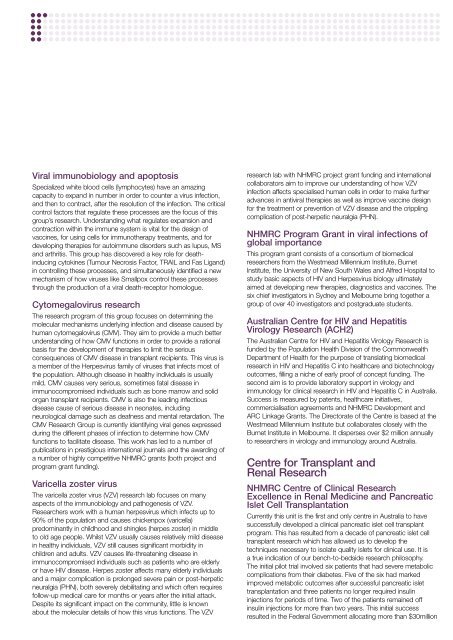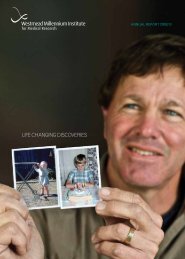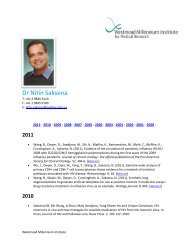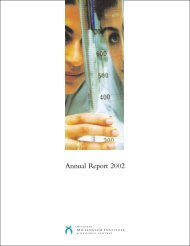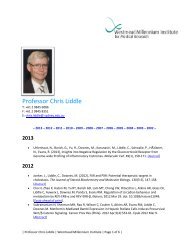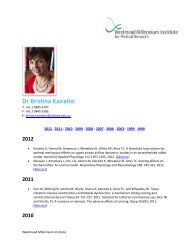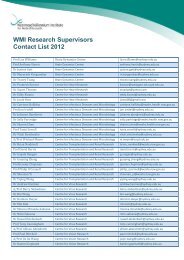Annual Report 2005 - Westmead Millennium Institute
Annual Report 2005 - Westmead Millennium Institute
Annual Report 2005 - Westmead Millennium Institute
Create successful ePaper yourself
Turn your PDF publications into a flip-book with our unique Google optimized e-Paper software.
Viral immunobiology and apoptosisSpecialized white blood cells (lymphocytes) have an amazingcapacity to expand in number in order to counter a virus infection,and then to contract, after the resolution of the infection. The criticalcontrol factors that regulate these processes are the focus of thisgroup’s research. Understanding what regulates expansion andcontraction within the immune system is vital for the design ofvaccines, for using cells for immunotherapy treatments, and fordeveloping therapies for autoimmune disorders such as lupus, MSand arthritis. This group has discovered a key role for deathinducingcytokines (Tumour Necrosis Factor, TRAIL and Fas Ligand)in controlling these processes, and simultaneously identified a newmechanism of how viruses like Smallpox control these processesthrough the production of a viral death-receptor homologue.Cytomegalovirus researchThe research program of this group focuses on determining themolecular mechanisms underlying infection and disease caused byhuman cytomegalovirus (CMV). They aim to provide a much betterunderstanding of how CMV functions in order to provide a rationalbasis for the development of therapies to limit the seriousconsequences of CMV disease in transplant recipients. This virus isa member of the Herpesvirus family of viruses that infects most ofthe population. Although disease in healthy individuals is usuallymild, CMV causes very serious, sometimes fatal disease inimmunocompromised individuals such as bone marrow and solidorgan transplant recipients. CMV is also the leading infectiousdisease cause of serious disease in neonates, includingneurological damage such as deafness and mental retardation. TheCMV Research Group is currently identifying viral genes expressedduring the different phases of infection to determine how CMVfunctions to facilitate disease. This work has led to a number ofpublications in prestigious international journals and the awarding ofa number of highly competitive NHMRC grants (both project andprogram grant funding).Varicella zoster virusThe varicella zoster virus (VZV) research lab focuses on manyaspects of the immunobiology and pathogenesis of VZV.Researchers work with a human herpesvirus which infects up to90% of the population and causes chickenpox (varicella)predominantly in childhood and shingles (herpes zoster) in middleto old age people. Whilst VZV usually causes relatively mild diseasein healthy individuals, VZV still causes significant morbidity inchildren and adults. VZV causes life-threatening disease inimmunocompromised individuals such as patients who are elderlyor have HIV disease. Herpes zoster affects many elderly individualsand a major complication is prolonged severe pain or post-herpeticneuralgia (PHN), both severely debilitating and which often requiresfollow-up medical care for months or years after the initial attack.Despite its significant impact on the community, little is knownabout the molecular details of how this virus functions. The VZVresearch lab with NHMRC project grant funding and internationalcollaborators aim to improve our understanding of how VZVinfection affects specialised human cells in order to make furtheradvances in antiviral therapies as well as improve vaccine designfor the treatment or prevention of VZV disease and the cripplingcomplication of post-herpetic neuralgia (PHN).NHMRC Program Grant in viral infections ofglobal importanceThis program grant consists of a consortium of biomedicalresearchers from the <strong>Westmead</strong> <strong>Millennium</strong> <strong>Institute</strong>, Burnet<strong>Institute</strong>, the University of New South Wales and Alfred Hospital tostudy basic aspects of HIV and Herpesvirus biology ultimatelyaimed at developing new therapies, diagnostics and vaccines. Thesix chief investigators in Sydney and Melbourne bring together agroup of over 40 investigators and postgraduate students.Australian Centre for HIV and HepatitisVirology Research (ACH2)The Australian Centre for HIV and Hepatitis Virology Research isfunded by the Population Health Division of the CommonwealthDepartment of Health for the purpose of translating biomedicalresearch in HIV and Hepatitis C into healthcare and biotechnologyoutcomes, filling a niche of early proof of concept funding. Thesecond aim is to provide laboratory support in virology andimmunology for clinical research in HIV and Hepatitis C in Australia.Success is measured by patents, healthcare initiatives,commercialisation agreements and NHMRC Development andARC Linkage Grants. The Directorate of the Centre is based at the<strong>Westmead</strong> <strong>Millennium</strong> <strong>Institute</strong> but collaborates closely with theBurnet <strong>Institute</strong> in Melbourne. It disperses over $2 million annuallyto researchers in virology and immunology around Australia.Centre for Transplant andRenal ResearchNHMRC Centre of Clinical ResearchExcellence in Renal Medicine and PancreaticIslet Cell TransplantationCurrently this unit is the first and only centre in Australia to havesuccessfully developed a clinical pancreatic islet cell transplantprogram. This has resulted from a decade of pancreatic islet celltransplant research which has allowed us to develop thetechniques necessary to isolate quality islets for clinical use. It isa true indication of our bench-to-bedside research philosophy.The initial pilot trial involved six patients that had severe metaboliccomplications from their diabetes. Five of the six had markedimproved metabolic outcomes after successful pancreatic islettransplantation and three patients no longer required insulininjections for periods of time. Two of the patients remained offinsulin injections for more than two years. This initial successresulted in the Federal Government allocating more than $30million


